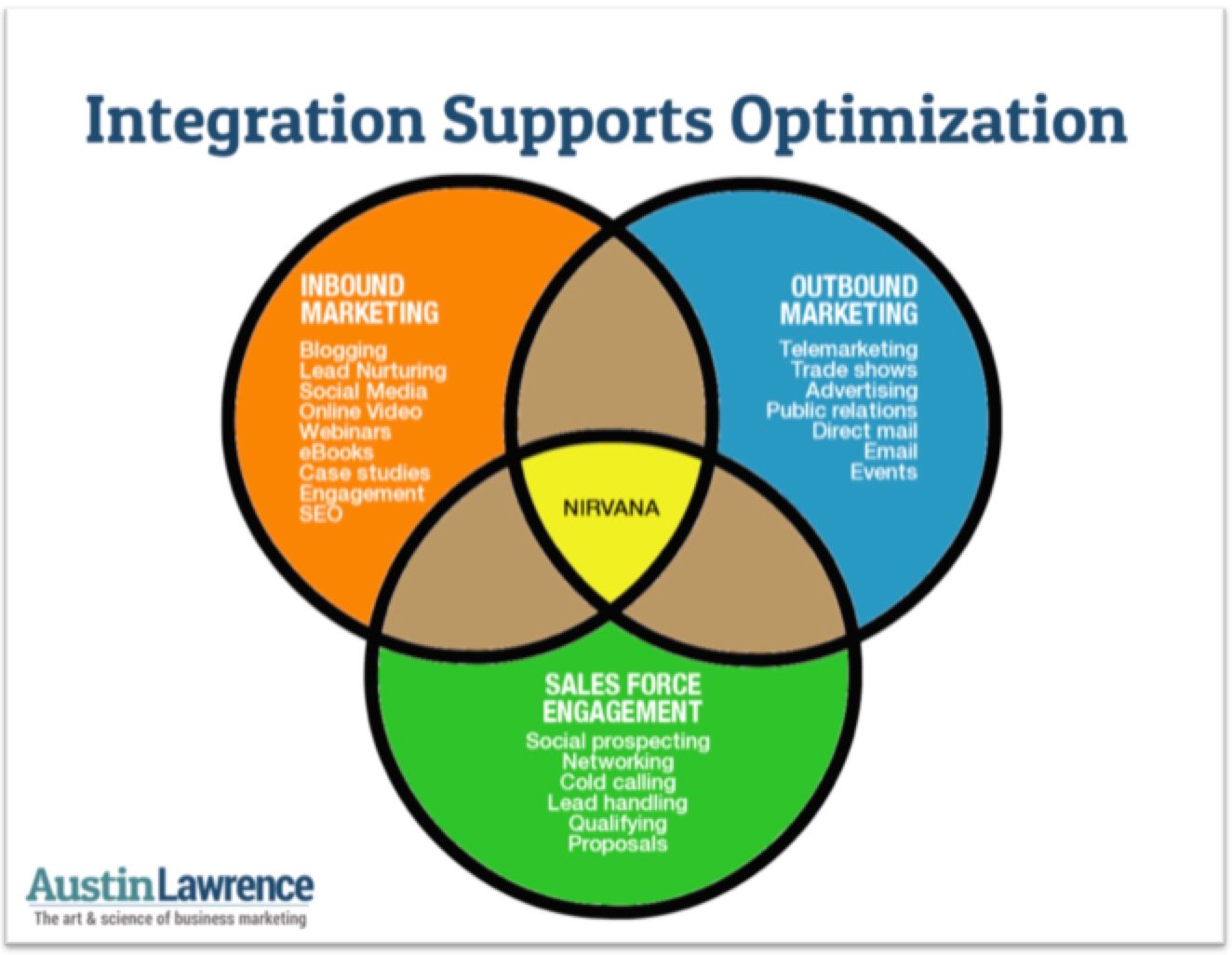Around since the mid-1990s, Account-Based Marketing (ABM) is a marketing strategy that has recently come to the forefront of B2B marketing. It is a recognition that for companies it is not economic to depend on having unknown customers "find them." Enterprise sales-focused marketers already know who their target customers are. As the name implies, this method operates at the individual account level, rather than focusing on generating new leads and sales.
In many ways, ABM resembles a “Land and Expand” strategy rather than the "waterfall" model so often cited in discussions of Inbound Marketing. We have realized in our own work with clients that many of the tools for ABM and Inboundare the same, but the approach and focus are very different. ABM requires sales and marketing teams collaborate to identify and target a smaller number the largest and most valuable accounts, then personalize the sales message to fit the needs of these accounts -- and associated personas -- at an individual level. So, while ABM does not depend on getting found on the search engines, your public-facing content is important and plays a big part of the lead nurturing effort. It is a nuance we delve into below...
Peapods & Marketing: What They Share
More than 100 years ago, an Italian economist named Vilfredo Pareto noticed that 20 percent of his peapods contained roughly 80 percent of the peas in his garden. The numbers struck him. In 1896, Pareto published his first paper, which showed that approximately 80 percent of the land in Italy was owned by 20 percent of the population.
The Pareto principle, or 80–20 Rule, is commonly recognized in the business:
- 80 percent of a company's profits come from 20 percent of its customers.
- 80 percent of a company's complaints come from 20 percent of its customers.
- 80 percent of a company's profits come from 20 percent of the time its staff spends.
- 80 percent of a company's sales come from 20 percent of its products.
- 80 percent of a company's sales are made by 20 percent of its sales staff.
Likewise, ABM will likely target the 20 percent of your existing or known accounts that provide (or have the potential to provide) the 80 percent of your sales and profits to maximize ROI. By focusing on boosting client engagement, deal size and marketing value, ABM can help retain and expand current business and create new opportunities at targeted accounts.
ABM is often adopted by companies seeking to differentiate in markets where products are easily commoditized. Marketing automation helps to coordinate personalized marketing and sales efforts that open doors and engage with accounts on a deeper level. Engaging, journey-based content builds deeper relationships with these multiple-purchase customers.

When Should I Use Account-based Marketing?
ABM fits best in the B2B mid-market and enterprise space where purchases involve multiple decision-makers or buyer personas. According to the Harvard Business Review, on average, 5.4 people now have to formally sign off on each purchase. As the buying decision becomes more complex and involves more people, reaching consensus to close deals has become a more painful process for both suppliers and customers. These are not people who will likely find you on Google. They will be part of the purchasing decision team.
That doesn't mean that you give up on your content marketing efforts. Here are some more decision-making statistics from Google to help get your mind around ABM:
- 64 percent of the C-suite have final sign off, but so do almost a quarter (24 percent) of the non-C-suite.
- 81 percent of non-C-suiters have a say in purchase decisions.
- 71 percent of B2B researchers start their research with a generic search.
- Those involved in the B2B buying process are already 57 percent of the way down the path to a decision before they'll actually perform an action on your site (or speak to a rep).
- Nearly half of all B2B researchers are 18-to 34-year-olds, an increase of 70 percent from 2012. So if you are not marketing to Millennials, then you may need to reconsider your strategy.
These people want facts to help them do their job. So, while you are targeting your efforts with ABM to build relationships with decision makers and influencers, you also need to supply relevant media they can explore on their own to make recommendations. Our approach is designed to provide a publishing framework to deliver the kinds of material necessary when trying to influence decision-makers.
In addition, email marketing and direct interaction with your sales team can be highly influential in promoting the "research" content you have available. We cover some other marketing techniques to help you personalize the online research conducted by your prospects.
The bottom line: if you are working from a targeted list of key accounts with multiple people involved in the decision process, then you should consider employing an account-based marketing strategy.
Why Do Companies Need an ABM Program?
ABM allocates scarce resources to the highest revenue potential, probability of close and other strategic benchmarks. ABM is designed to enable and equip sales for efficient and cost-effective selling cycles by focusing their activity on the most valuable accounts.
ABM aligns sales and marketing, requiring the two to cooperate from the start. Smarketing, as HubSpot calls it, commonly used in B2B companies where marketing supports sales to achieve specific objectives and activities, such as:
- Selecting and prioritizing account lists.
- Building account plans.
- Generating new contacts within key accounts.
- Gathering accounts, intelligence for use by sales teams.
- Running field-marketing events.
- Prospecting into new relationships.
- Engaging accounts online.
Marketers adopting ABM programs must collaborate with sales and/or outside agencies to define account goals and plans—lead scoring & nurturing, capturing marketing activities in HubSpot Timeline and tasking features are all features that support the effort. Gathering up-to-date account intelligence and contact information are another major responsibility.
The need to align sales and marketing is highlighted in this SiriusDecisions survey from last year:
- 100 percent of companies practicing ABM claim marketing resources were at least somewhat aligned with sales, with 34 percent saying they were tightly aligned.
- 74 percent work with sales to define account goals and plans, and 67 percent get help from sales on account insights.
- 92 percent of companies recognize the value in ABM, but only 20 percent have had full programs in place for more than one year.
- 52 percent of respondents currently have ABM pilot programs in place.
- 47 percent of companies don’t feel that their ABM teams have the skills needed for ABM and that marketing teams need more support to succeed.
How Do You Measure ABM Efforts?
According to account-based outbound marketing platform company Engagio, ABM has five big metrics:
- Coverage. Do you have sufficient data, contacts, and account plans for each specific account?
- Awareness. Are the target accounts aware of your company and its solutions? Are they coming to your events and reading your materials? Does your sales team know that an account has been interacting with your content?
- Engagement. Are the right people at the account spending time with your company, and is that engagement going up over time?
- Program impact. Are marketing programs reaching the target accounts, and are they having a long-term effect?
- Influence. How are the ABM activities, making an impact? Are they improving sales outcomes such as deal velocity, win rates, average contract values, retention and net promoter scores?
How to Use Account-based Marketing
Although ABM is not primarily a search-based discovery model for customers, web presence is still an important component of the strategy.
Targeted content offers ensure that you’re creating the most relevant experience possible for your accounts. Targeted content can be organized by persona, funnel stage, topic or type (educational, competitive, etc.).
Website personalization involves using IP addresses to target accounts and create unique experiences based on visits to that company. Account-based marketing is based on supporting the customer’s collective decision-making process, and it is easy to target the collective with IP-based targeting.
HubSpot’s Smart Content alters the content displayed within rich-text, HTML, or form modules depending on viewer characteristics. Smart Content can be tailored to anonymous visitors based on their location, device, or referral source. You can also tailor content to known visitors based on Smart lists, or the contacts life cycle stage. By creating Smart Lists that recognize your different life cycle stages, you can customize the content that people in each life cycle stage will see.
HubSpot found that personalized content performs significantly better. HubSpot looked at the data for more than 93,000 calls to action created using HubSpot over a 12 month period and found that Calls-to-action targeted to the user performed 42 percent better than generic calls-to-action.
Does ABM differ from Marketing Automation?
Marketing automation helps to coordinate personalized marketing and sales efforts that open doors and deepen engagement within accounts based on customer knowledge. ABM uses marketing automation tools to implement tactics such as:
- IP-based targeting and custom content to provide custom experience and guide visitors.
- CRM integration gives the Sales team access to market intelligence, such as documents shared and read, videos watched, emails opened, survey responses and webinar attendance.
- Lead nurturing provides information to buyers based on their deal stage.
- Coordinates customer-wide insight about conversations had by everybody on your team.
Get Started with Your Account-Based Marketing Strategy
Being an outbound strategy, ABM works very differently from inbound marketing. However, the ABM strategy does share several steps with inbound:
- Determine target accounts (filter, shortlist, profile)—know the decision makers and the researchers.
- Create buyer personas (2-5 people within the company in various job/positions).
- Develop content strategy & editorial calendar (informational and educational, not entertainment).
- Find & engage people outside of our known realm or people with a targeted account; document interactions in CRM.
- Educate and inform with coordinated information from Marketing and Sales .
- Create urgency.
- Measure & optimize performance.
- Delight.
Where do ABM and Inbound Marketing Converge?
Many ABM activities can be automated so that messages reach buyers on their schedule, taking the onus off the sales team to remember to take an action. Therefore, ABM tactics can easily co-exist within an inbound marketing program and the prospecting efforts of your sales team. We call this "Nirvana."
Convergence is the “Nirvana” achieved when inbound, outbound (like ABM) & sales prospecting/nurturing occurs. Inbound marketing is a means to use content to attract leads from people who search, while outbound marketing is made up of messages you “push” out into the marketplace. Sales/sales prospecting and nurturing is a manual process that involves calling or personally emailing prospects. Use ABM to target, close and nourish your most valuable accounts, and use inbound marketing to attract interest from thousands of other viable accounts. Whether you’re working within a broad market or account-based marketing, all of your efforts must come together.
If you would like to find marketing nirvana for your company, we would be pleased to provide you an Inbound Marketing Assessment (IMA), or a one-day strategy design workshop, to get you started. Our custom diagnostic within the IMA will demonstrate for you the audience economics you need to achieve with your website based on your unique sales funnel. The IMA also offers a competitive review, benchmarks against best practices and a recommended program to fill your pipeline. It is a valuable tool and we invite you to give it a try. Tell us your needs and we’ll design a business-building, make that relationship-building, program for you.
Click below to get started!









